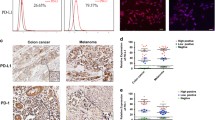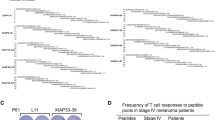Abstract
Aberrantly expressed or mutated proteins in cancer cells evoke immune recognition, but host reactions are usually insufficient to prevent disease progression. Vaccination with irradiated tumor cells engineered to secrete granulocyte-macrophage colony stimulating factor (GM-CSF) augments host immunity through improved tumor antigen presentation by recruited dendritic cells and macrophages. By analyzing the immune response of a metastatic melanoma patient who achieved a long-term response to vaccination, we identified melanoma inhibitor of apoptosis protein (ML-IAP) as a target for immune-mediated tumor destruction. Vaccination stimulated a coordinated cellular and humoral reaction to ML-IAP that was associated with extensive tumor necrosis, whereas lethal disease progression was linked with the loss of ML-IAP expression and the absence of intra-tumoral lymphocyte infiltrates. These findings demonstrate that ML-IAP can serve as a tumor rejection antigen, although additional vaccine targets will be required to circumvent immune escape and tumor heterogeneity.
Similar content being viewed by others
References
Dranoff G. Immune recognition and tumor protection. Curr Opin Immunol 2002; 14: 161–164.
Diefenbach A, Raulet D. The innate immune response to tumors and its role in the induction of T-cell immunity. Immunol Rev 2002; 188: 9–21.
Karre K. NK cells, MHC class I molecules and the missing self. Scan J Immunol 2002; 55: 221–228.
Boon T, van der Bruggen P. Human tumor antigens recognized by T lymphocytes. J Exp Med 1996; 183: 725–729.
Old L, Chen Y-T. New paths in human cancer serology. J Exp Med 1998; 187: 1163–1167.
Banchereau J, Briere F, Caux C, et al. Immunobiology of dendritic cells. Annu Rev Immunol 2000; 18: 767–811.
Young JW, Inaba K. Dendritic cells as adjuvants for class I major histocompatibility complex-restrictied antitumor immunity. J Exp Med 1996; 183: 7–11.
Dranoff G, Jaffee E, Lazenby A, et al. Vaccination with irradiated tumor cells engineered to secrete murine granulocyte-macrophage colony-stimulating factor stimulates potent, specific, and long-lasting anti-tumor immunity. Proc Natl Acad Sci USA 1993; 90: 3539–3543.
Mach N, Gillessen S, Wilson SB, Sheehan C, Mihn M, Dranoff G. Differences in dendritic cells stimulated in vivo by tumors engineered to secrete granulocyte-macrophase colony-stimulating factor or flt3–ligand. Cancer Res 2000; 60: 3239–3246.
Huang AY, Golumbek P, Ahmadzadeh M, Jaffee E, Pardoll D, Levitsky H. Role of bone marrow-derived cells in presenting MHC class I-restricted tumor antigens. Science 1994; 264: 961–965.
Reilly R, Machiels J-P, Emens L, et al. The collaboration of both humoral and cellular HER-2/neu-targeted immune responses is required for the complete eradication of HER-2/neu-expressing tumors. Cancer Res 2001; 61: 880–883.
Gillessen S, Naumov YN, Nieuwenhuis EE, et al. CD1d-restricted T cells regulate dendritic cell function and antitumor immunity in a granulocyte-macrophage colony-stimulating factor-dependent fashion. Proc Natl Acad Sci USA 2003; 100: 8874–8879.
Soiffer R, Lynch T, Mihm M, et al. Vaccination with irradiated, autologous melanoma cells engineered to secrete human granulocyte-macrophage colony stimulating factor generates potent anti-tumor immunity in patients with metastatic melanoma. Proc Natl Acad Sci USA 1998; 95: 13141–13146.
Berkner KL. Development of adenovirus vectors for the expression of heterologous genes. Biotechniques 1988; 6: 616–629.
Soiffer R, Hodi FS, Haluska F, et al. Vaccination with irradiated, autologous melanoma cells engineered to secrete granulocyte-macrophage colony-stimulating factor by adenoviral-mediated gene transfer augments antitumor immunity in patients with metastatic melanoma. J Clin Oncol 2003; 21: 3343–3350.
Schmollinger JC, Vonderheide RH, Hoar KM, et al. Melanoma inhibitor of apoptosis protein (ML-IAP) is a target for immune-mediated tumor destruction. Proc Natl Acad Sci USA 2003; 100: 3398–3403.
Vucic D, Stennicke H, Pisabarro M, Salvesen G, Dixit V. ML-IAP, a novel inhibitor of apoptosis that is preferntialy expressed in human melanomas. Curr Biol 2000; 10: 1359–1366.
Kasof GM, Gomes BC. Livin, a novel inhibitor-of-apoptosis (IAP) family member. J Biol Chem 2000; 276: 3238–3246.
Lin J-H, Deng G, Huang Q, Morser J. KIAP, a novel member of the inhibitor of apoptosis protein family. Biochem Biophys Res Comm 2000; 279: 820–831.
Ashhab Y, Alian A, Polliack A, Panet A, Yehuda DB. Two splicing variants of a new inhibitor of apoptosis gene with different biological properties and tissue distribution pattern. FEBS Lett 2001; 495: 56–60.
Manis J, Tian M, Alt F. Mechanism and control of class-switch recombination. Trends Immnol 2002; 23: 31–39.
Parker KC, Bednarek MA, Coligan JE. Scheme for ranking potential HLA-A2 binding peptides based on independent binding of individual peptide side-chains. J Immunol 1994; 152: 163–175.
Altman J, Moss P, Goulder P, et al. Direct visualization and phenotypic analysis of virus-specific T lymphocytes in HIV-infected individuals. Science 1996; 274: 94–96.
Hanahan D, Weinberg RA. The hallmarks of cancer. Cell 2000; 100: 57–70.
Barks JH, Thompson FH, Taetle R, et al. Increased chromosome 20 copy number detected by fluorescence in situ hybridization (FISH) in malignant melanoma. Genes Chromosomes Cancer 1997; 19: 278–285.
Korn WM, Yasutake T, Kuo WL, et al. Chromosome arm 20q gains and other genomic alterations in colorectal cancer metastatic to liver, as analyzed by comparative genomic hybridization and fluorescence in situ hybridization. Genes Chromosomes Cancer 1999; 25: 82–90.
Gazzaniga P, Gradilone A, Giuliani L, et al. Expression and prognostic significance of LIVIN, SURVIVIN and other apoptosis-related genes in the progression of superficial bladder cancer. Ann Oncol 2003; 14: 85–90.
Sanna MG, da Silva Correia J, Ducrey O, et al. IAP suppression of apoptosis involves distinct mechanisms: The TAK1/JNK1 signaling cascade and caspase inhibition. Mol Cell Biol 2002; 22: 1754–1766.
Nachmias B, Ashhab Y, Bucholtz V, et al. Caspase-mediated cleavage converts Livin from an antiapoptotic to a proapoptotic factor: Implications for drug-resistant melanoma. Cancer Res 2003; 63: 6340–6349.
Nishihara H, Kizaka-Kondoh S, Insel PA, Eckmann L. Inhibition of apoptosis in normal and transformed intestinal epithelial cells by cAMP through induction of inhibitor of apoptosis protein (IAP)-2. Proc Natl Acad Sci USA 2003; 100: 8921–8926.
Pardo OE, Lesay A, Arcaro A, et al. Fibroblast growth factor 2–mediated translational control of IAPs blocks mitochondrial release of Smac/DIABLO and apoptosis in small cell lung cancer cells. Mol Cell Biol 2003; 23: 7600–7610.
Hong X, Lei L, Glas R. Tumors acquire inhibitor of apoptosis protein (IAP)-mediated apoptosis resistance through altered specificity of cytosolic proteolysis. J Exp Med 2003; 197: 1731–1743.
Vucic D, Deshayres K, Ackerly H, et al. SMAC negatively regulates the anti-apoptotic activity of melanoma inhibitor of apoptosis (ML-IAP). J Biol Chem 2002;277: 12275–12279.
Yang QH, Church-Hajduk R, Ren J, Newton ML, Du C. Omi/HtrA2 catalytic cleavage of inhibitor of apoptosis (IAP) irreversibly inactivates IAPs and facilitates caspase activity in apoptosis. Genes Dev 2003; 17: 1487–1496.
Crnkovic-Mertens I, Hoppe-Seyler F, Butz K. Induction of apoptosis in tumor cells by siRNA-mediated silencing of the livin/ML-IAP/KIAP gene. Oncogene 2003; 22: 8330–8336.
Franklin MC, Kadkhodayan S, Ackerly H, et al. Structure and function analysis of peptide antagonists of melanoma inhibitor of apoptosis (ML-IAP). Biochemistry 2003; 42: 8223–8231.
Chen Y, Kramer DL, Li F, Porter CW. Loss of inhibitor of apoptosis proteins as a determinant of polyamine analog-induced apoptosis in human melanoma cells. Oncogene 2003; 22: 4964–4972.
Yagihashi A, Asanuma K, Tsuji N, et al. Detection of anti-livin antibody in gastrointestinal cancer patients. Clin Chem 2003; 49: 1206–1208.
Andrade F, Roy S, Nicholson D, Thornberry N, Rosen A, Casciola-Rosen L. Granzyme B directly and efficienly cleaves several downstream caspase substrates: Implications for CTL-induced apoptosis. Immunity 1998: 8: 451–460.
Thomas D, Du C, Xu M, Wang X, Ley T. DFF45/ICAD can be directly processed by granzyme B during the induction of apoptosis. Immunity 2000; 12: 621–632.
Sutton VR, Davis JE, Cancilla M, et al. Initiation of apoptosis by granzyme B requires direct cleavage of bid, but not direct granzyme B-mediated caspase activation. J Exp Med 2000; 192: 1403–1414.
Heibein JA, Goping IS, Barry M, et al. Granzyme B-mediated cytochrome c release is regulated by the Bcl-2 family members bid and Bax. J Exp Med 2000; 192: 1391–1402.
Zhang D, Beresford PJ, Greenberg AH, Lieberman J. Granzymes A and B directly cleave lamins and disrupt the nuclear lamina during granule-mediated cytolysis. Proc Natl Acad Sci USA 2001; 98: 5746–5751.
Liston P, Fong WG, Korneluk RG. The inhibitors of apoptosis: Thereis more to life than Bcl2. Oncogene 2003; 22: 8568–8580.
Andersen MH, Pedersen LO, Capeller B, et al. Spontaneous cytotoxic T-cell responses against surviving-derived MHC class I-restricted T-cell epitopes in situ as well as ex vivo in cancer patients. Cancer Res 2001; 61: 5964–5968.
Andersen MH, Pedersen LO, Becker JC, Straten PT. Identification of a cytotoxic T lymphocyte response to the apoptosis inhibitor protein surviving in cancer patients. Cancer Res 2001; 61: 869–872.
Hirohashi Y, Torigoe T, Maeda A, et al. An HLA-A24–restricted cytotoxic T lymphocyte epitope of a tumor-associated protein, surviving. Clin Cancer Res 2002; 8: 1731–1739.
Rohayem, J, Diestelkoetter P, Weigle B, et al. Antibody response to the tumor-associated inhibitor of apoptosis protein surviving in cancer patients. Cancer Res 2000; 60: 1815–1817.
Author information
Authors and Affiliations
Corresponding author
Rights and permissions
About this article
Cite this article
Schmollinger, J.C., Dranoff, G. Targeting melanoma inhibitor of apoptosis protein with cancer immunotherapy. Apoptosis 9, 309–313 (2004). https://doi.org/10.1023/B:APPT.0000025807.59668.5e
Issue Date:
DOI: https://doi.org/10.1023/B:APPT.0000025807.59668.5e




